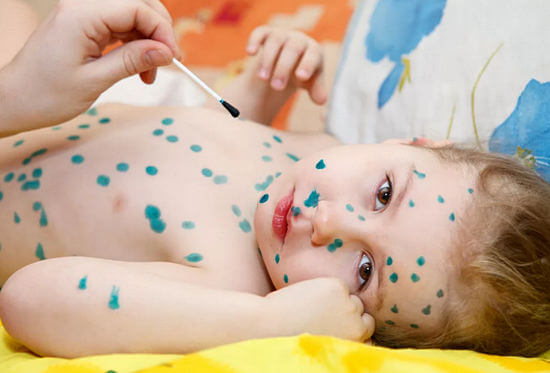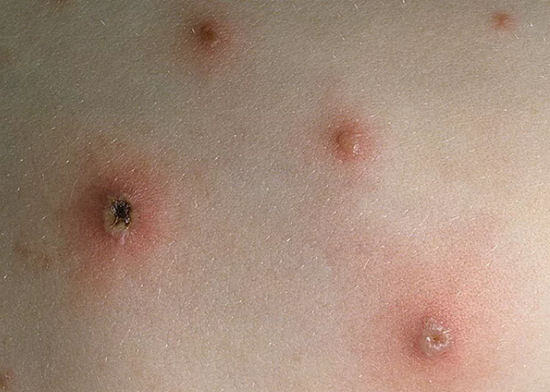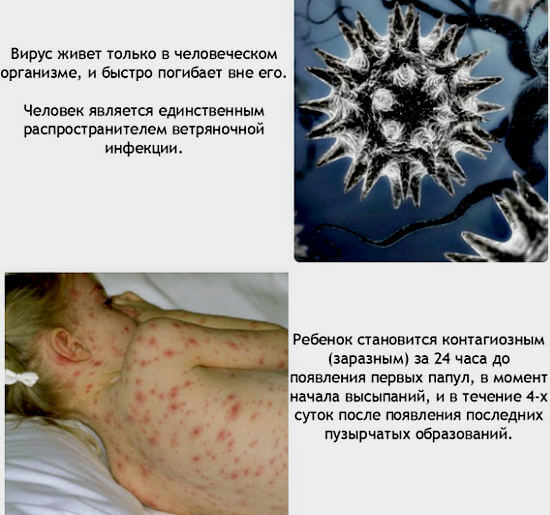Chickenpox in children - symptoms and treatment, stages of chickenpox, prevention
Chickenpox in children(see photo), what causes it, how infection occurs, signs and symptoms of chickenpox, possible complications, recommended care and treatment, all this is detailed on the website.
What is chicken pox (chickenpox)
Chicken pox is one of the most common acute infectious diseases. It is mostly common among children, but the adult population is also affected. Highly contagious, transmitted through the air, even just by being in a room with an infected person at the same time.
In adults, in the vast majority of cases, chickenpox is much more severe than in children. Since there is a possibility of serious complications in the form of chicken pneumonia or encephalitis.
Therefore, young mothers have a belief that it is better not to escape with the baby from chickenpox quarantine in kindergarten, at school, when the disease is not so problematic than to wait for a severe fever, complications and a 3-week absence from work already in an adult.
Causes, causative agent of chickenpox, incubation period
Chickenpox infection belongs to the herpes family of diseases, respectively pathogen- 3 types (Varicella-Zoster). It also causes shingles.
The majority of people, about 80-90%, suffer from this disease in childhood or adolescence. Human sensitivity to this infection is quite high. Often, children who catch chickenpox bring it from kindergarten or from school. The infection comes from another infected person.
After a person has suffered this disease once, it is formed for life. In isolated cases, re-infection occurs, the cause of which is often various stressful situations and nervous strain. Chickenpox can also be passed from a pregnant woman to an unborn child, which very often leads to an earlier birth, sometimes to the death of the fetus.
Incubation period infections last an average of one to three weeks. At this time, no changes are felt in well-being. During the incubation period, chickenpox is not contagious. The disease is most dangerous for others mainly:
- - when the first rashes appear on the body;
- - after the manifestation of the last papules for several days;
- - two or three days before the first rash.
The average duration of chickenpox is 10-15 days. At first, the infected person constantly develops new rashes, and the body temperature rises.
The next 5-7 days, the process seems to be suspended. Further, the rash begins to take a crust.
In children under 1 year of age, chickenpox resolves quickly, without complications, and mostly without consequences. During the period of illness, a person needs to isolate himself from others in order to avoid further spread of the infection. After the disappearance of the last rashes on the body, a person can again enter the normal rhythm of life.

Symptoms of chickenpox in children
The characteristic signs of chicken pox are a rash all over the body, fever, and the appearance of general intoxication. Children become infected much faster than adults.
At first, red spots appear on the skin, after an hour or two they become convex (papules) and already look like small bubbles that are filled with a clear liquid. The size of the bubbles varies from 0.1 to 0.5 mm, they can be round or oblong. Around the corolla of reddened skin. The rash appears all over the body, but most of all it affects the head and neck, as well as the abdomen, inguinal zones.
A few days later, the vesicles (vesicles) become cloudy, begin to dry out slightly, burst, and a crust forms in their place. After the crusts fall off, small scars may remain in their place, first brown, then whitish. Especially often this happens with intensive combing.
In adults, at the last stage of the disease, ulcers often form instead, and the rash continues to spread throughout the body longer and more abundantly than in children.
Rashes with chickenpox can exist on the skin of a child at the same time - and specks, and papules, and vesicles (like blisters), and crusts. All of them are accompanied by severe itching, especially when localized on the mucous membranes.
Each time when new rashes appear on the body, the body reacts to them with an increase in temperature. This is normal, you should not panic. When the rash dries up, the temperature returns to normal. After the infection completely leaves the body, intoxication also disappears.

Stages of chickenpox, time of illness
Doctors distinguish several stages of chickenpox:
- — initial stage (incubation period) in children and youth - 2 weeks, in adults - from 11 days to 3 weeks;
it starts from the moment when there was contact with a sick person, on whose body there were already rashes in the form of redness, or who himself was in the prodromal period, a day or two before the onset of an acute illness.
- — prodrome(24-48 hours before the first rash);
during this period there is an active reproduction of the infection in the body. Viral cells divide, affecting the upper respiratory tract, symptoms of a small cold are possible (a slight fever, sore throat, sneezing, weakness, headaches are typical), at this time the infection actively multiplies in the blood of an infected person.
- — periods of rash and crusting;
The virus infects the skin, causing redness and a rash, accompanied by a sharp rise in temperature. It is during this period that the immune system begins to fight, producing the release of protective antibodies.
An increase in temperature is characteristic of the mass appearance of a rash, since the rash appears in waves, febrile states with periods without fever can also be interspersed.
Basically, the entire period of chickenpox disease lasts two weeks, there are cases when it is delayed up to three weeks or reduced to 10 days.

Treatment of chickenpox in children
Chickenpox is treated at home. In some severe cases, the patient needs hospitalization.
The chickenpox disease does not require special treatment, just until all the rashes on the body disappear, the patient must be isolated, and doctors also recommend bed rest, lasting about 7 days.
If possible, change clothes and bedding every day. It is desirable that the fabrics are natural.
During the infectious period, you need to drink plenty of fluids (it is better not to drink concentrated juices in their pure form, you need to dilute them in a ratio of 1: 1), and experts also recommend following a diet, including fruit and vegetable purees, and milk porridge in the diet. For the period of chickenpox, you need to forget about spicy and sour foods.
With home treatment of chickenpox, vesicles and redness on the skin are treated with a saturated solution of potassium permanganate (potassium permanganate) or lubricated with ordinary brilliant green.
When rashes appear on the mucous membranes, for example in the mouth, it is necessary to rinse the oral cavity with a tablet of furacilin dissolved in water. You can not scratch the places where there is itching. Otherwise, there is a possibility of infection in the wounds. If this happens, the healing period may be delayed for a longer time.
After the crusts fall off, it is possible to lubricate the remaining scars with any vegetable oil for speedy healing (therapeutic effect due to the presence of vitamin E). For sterilization, the oil is kept for 10 minutes in a water bath.
Subject to bed rest, it is impossible to warm the body with a blanket, as with profuse sweating, the itching may intensify. To relieve severe itching, you can apply a damp washcloth chilled in the refrigerator to the itchy area.
The doctor may advise antihistamines to reduce itching - Diazolin, Suprastin, etc.
If the body temperature rises above 38 - 38.5 degrees, doctors recommend taking drugs based on Paracetamol or Ibuprofen. Acetylsalicylic acid to reduce fever with chickenpox is completely contraindicated, since there is a possibility of developing Reye's syndrome (fatty degeneration of the liver with symptoms of encephalopathy).
Quite rare, but there are cases of appearance, which is not transmitted by airborne droplets, therefore, does not pose a danger to others.
Also, chicken pox can provoke the development of encephalitis, which often leads to inflammation in the cerebral cortex. If the behavior of the child during the period of the disease noticeably worsens, it is necessary to immediately contact a specialist in order to avoid undesirable consequences.
Chickenpox prevention
For those who have not yet had chickenpox, you need to follow some rules as a prevention of the disease:
- - if one of the relatives is ill with chickenpox, it is necessary to completely isolate him from the rest;
- - taking antiviral medications prescribed by a family doctor;
- - quartzization of the room; use the lamp strictly according to the instructions;
- - the sick person needs to be given separate dishes, and, if possible, change the bed and underwear daily;
- - all family members must wear gauze bandages, and iron them as often as possible in order to disinfect.
Often, in order not to catch the herpes virus in the form of chickenpox, adults and children are vaccinated with Okavax, Varilrix.
After that, the likelihood of getting sick becomes less, and if a person catches an infection, then its course will not be so severe, and the body will overcome it much faster.
Naturally, preventive measures do not give a 100% guarantee that a person is protected from chickenpox, but they should be followed to minimize the risk of infection. Doctors often recommend eating right as a preventive measure.
It is necessary to saturate the diet with products of exclusively natural origin, as well as include foods rich in vitamins and minerals, plus add sports to harden the body and acquire strong immunity that can protect against any infection.
